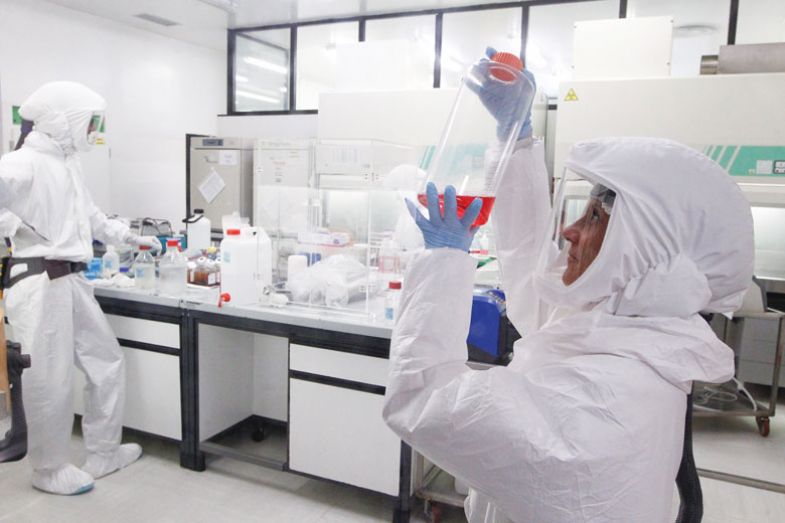When I was a child, one of my favourite activities was watching science documentaries. I specifically recall enjoying those featuring Jacques Cousteau, a French national hero, developer of the aqualung and director of the Oceanographic Museum of Monaco. Many years later, however, I learned that a biological release from the museum while Cousteau was director resulted in an ecological disaster for the Mediterranean.
Caulerpa taxifolia is a tropical sea alga that was a popular ornamental plant for home and museum aquaria. Originating in Queensland, Australia, it was bred in the Wilhelma Zoo in Stuttgart as a hardy, cold-resistant strain that reproduced asexually. It was shared with the Oceanographic Museum in 1982 and, two years later, a square metre of Caulerpa taxifolia was found in the Mediterranean under the museum’s base. Unfortunately, it was not removed and it spread invasively from there, displacing native species. Its dispersion, like that of emerging viruses, seems to have been facilitated by modern modes of transportation (yachts).
In 1990, University of Nice Sophia Antipolis professor Alexandre Meinesz tried to draw attention to the threat, as documented in his 1999 book, Killer Algae: The True Tale of a Biological Invasion. Release from the museum was fervently denied by François Doumenge, who had succeeded Cousteau as its director. Yet comparison of the genetic information of the alga in the Mediterranean with that of the aquarium strains has confirmed the high likelihood that the source of the ecologically devastating incursion was the museum.
This episode in genetic selection came to mind because of the recent focus on “gain-of-function” research, and particularly the ongoing debate about whether the Sars-CoV-2 virus (which causes Covid-19) was released from a laboratory.
Here some context is necessary. New technologies will generally have both good and bad consequences, and there will be some ambiguity in their assignment to those two categories. In addition, any new technology is going to have unanticipated effects. For example, agriculture is based on domestication: genetic modification, in other words. Its advent was positive for humans as a species because it allowed greater population density, but negative for the environment (for the same reason). It is also widely agreed to have had the negative effect of leading to vast disparities in wealth and power. Unanticipated consequences include tooth decay.
When we talk of “unanticipated effects”, we mean unanticipated by the originators and propagators of the technology – and we include possible known consequences whose significance was dismissed. Frequently, someone expected some of the negative outcomes, but no one foresaw them all.
Our human ancestors have been engaged in genetic engineering in the form of selective breeding for millennia. Artificial selection has given us maize that barely resembles teosinte, dachshunds that are not wolves, pigeons that tumble (critical to the argument in Darwin’s On the Origin of Species) and tasteless supermarket tomatoes. Modern molecular-biological technologies are both more powerful and more precise than these techniques, but modern genetic engineering can only be understood as on a continuum with older approaches and all of the above comments about new technologies still apply.
Let us define viral “gain-of-function” research as experimentation that investigates how a virus can increase in transmissibility or pathogenicity. It should be noted that, under this definition, “gain of function” could arise from mutations that geneticists would categorise as a “loss of function”.
A virus is a nucleic acid (almost always either RNA or DNA) with a protein coat. It enters cells to achieve its objective, the same one that any life form has – to replicate its nucleic acid. It uses cellular metabolites and synthetic machinery in collaboration with its own components to achieve that end. It also needs to be understood that viruses are highly dynamic microbes. In an infected organism, the high rate of mutation in viruses means that what we find is really an ensemble of genetically related but distinct viral entities.
Viruses are a standard component of the earth’s ecology. Research on them is essential for understanding life and its origins on this planet. Humans are continually exposed to viruses, of which the vast majority do us no serious harm. Pathogenic viruses are typically those that have breached an ecological barrier and are often introduced through contact with another animal species.

There are four criteria for the propagation between human hosts of a disease-causing virus. First, the virus must be capable of both entering and replicating in human cells. Second, the virus must be able to escape the relatively nonspecific antiviral defence systems and, sometimes, pre-existing immune responses. Third, the virus must be transmissible between humans. Finally, the virus must cause disease either by direct deleterious effects to cells and tissues or – as is more common in humans – by provoking an immune response that injures cells and tissues.
Viral “gain-of-function” research could potentially involve any of these four capacities. Investigation of the ability to enter and replicate in human cells is a routine component of virological research. It is not enough to determine that a virus can enter and replicate in some human cells. Identifying the exact types of cells in which replication can occur is also critical. In the course of such experiments, because of repeated passage of the virus through cells, variants evolve that increase levels of infection in a particular cell or group of cell types.
Researchers have learned much about viruses through these experiments. In recent times, they have also introduced genetic changes through molecular-biological manipulation to test hypotheses about how changes occur in the range of hosts where the virus can reproduce.
A virus may enter and replicate in cultured human cells, but that doesn’t mean it will infect humans. There are innate defences that need to be overcome. We have in recent decades arrived at an understanding of the operation of these defences, but our proficiency at producing viruses with the ability to breach these defences is limited; serendipity plays a major role.
Finding viruses that can escape pre-existing antibodies or T-cell responses is now a common avenue of research, critical to the design of vaccines, for example. Studies can use traditional or modern molecular-biological approaches.
In addition, there are unnatural defences against viruses: pharmaceutical antivirals. In order to understand how easily viruses are capable of evolving resistance to an antiviral, we make use of a concentration of antiviral that reduces viral replication but does not stop the virus completely and thus allows for viruses that are insensitive to the antiviral to evolve. A common finding is that one apparent “gain of function” actually comes with a vulnerability that can potentially be exploited for prevention or treatment of infection.
Viruses can be transmitted between humans by a number of routes. Respiratory and gastrointestinal transmission are common. Viruses can also be transferred by skin and sexual contact, through contaminated blood or from mother to child, during either pregnancy or the birthing process. In addition, viruses can be disseminated to humans by other animals, through insect bites, for example. Scientists currently have restricted powers to generate enhanced transmissibility through “gain-of-function” experiments, although a general increase in viral potency could have that effect. Of course, viruses have also evolved naturally to have these transmission properties, which can be exploited through engineering in applications involving, for example, gene transfer or gene therapy.
Some viruses by their very nature must destroy the cells they infect in order to spread, although this need not lead to overt disease. Yet many viruses do not have to kill cells in order to be released. Frequently, the tissue damage that results in illness is produced not by viral replication per se but by an inappropriate or unbalanced inflammatory immune response. Our understanding of which viral components trigger harmful defence reactions and how they do so is limited. Nevertheless, some of the earliest experiments bringing viral “gain-of-function” research to public attention involved the insertion of an immunomodulator, Interleukin-4, into mousepox and rabbit myxoma viruses. More highly virulent viruses arose. It is still unclear whether severe disease occurred because of immunosuppression and consequent higher viral loads or immunopathology.
Conceptually, one might think of the purposes of viral “gain-of-function” research as falling into three categories. The first is the investigation of the nature of viruses; increased understanding could provide insight into how we could prevent and treat viral infections either for a specific class of viruses or for viruses as a group. The second is the development of a virus as a bioweapon. One can imagine a virus being unleashed against a pest or pathogen; one could also imagine a virus being deployed against humans in either a military or civilian context. Clearly, the latter form of experimentation is unethical and foolish; viruses are dynamic entities and could evolve to assault their creators, like Frankenstein’s monster. Even the former is not without substantial risk.
The third kind of research is designed to protect a population against a specific perceived threat. For example, if it proves necessary to develop an ongoing vaccine programme for immunisation against Sars-CoV-2 variants, such experimentation might prove critical for achieving the greatest success.
There clearly have been and are scientific benefits to viral “gain-of-function” experimentation. Modern technology, in general, renders mankind both safer (witness the rapidity of the development of the Sars-CoV-2 vaccines) and more vulnerable. The question in the minds of many is whether the benefits of the investigations outweigh the risks associated with accidental or deliberate release of viruses modified by artificial selection or molecular-biological manipulation.
It would be delusional to argue that there are no risks. But an exclusive focus on such “gain-of-function” research seems to me misdirected. There have been numerous examples of infections attributed to laboratory accidents that were caused by viruses that were not deliberately modified. The 1977 H1N1 influenza emerged in the USSR or northern China and was clearly a descendant of a 1950s H1N1 virus that had become extinct in the human population in 1957. Its genetic makeup and the demographics of infection provided convincing evidence that it had been reintroduced into the human population from a stored viral stock.
There have also been multiple instances of accidental infections by filoviruses, the highly pathogenic family that includes the Ebola and Marburg viruses, occurring at the State Research Center of Virology and Biotechnology, known as Vector, in Koltsovo, near Novosibirsk in Russia. It was reportedly the site of biological weapons development during the era of the Soviet Union and is one of only two known repositories of the smallpox virus. I had the privilege of visiting Vector twice as a participant in the US Defense Threat Reduction Agency’s Biological Weapons Proliferation Program, once soon after the 2004 Ebola infection and subsequent death of a Vector researcher.
The program was an outgrowth of the Nunn-Lugar Cooperative Threat Reduction Program, which was designed to secure and dismantle weapons of mass destruction in the states of the former Soviet Union. A major focus of the biological weapons strand was to prevent the expertise necessary to turn pathogenic agents into bioweapons from becoming available to terrorist organisations or “rogue nations”. My involvement convinced me that the proliferation of technical proficiency in the propagation of dangerous viruses was a serious threat.
This conclusion was reinforced when it was alleged by the Federal Bureau of Investigation that a mentally unstable individual named Bruce Ivins – a researcher at the US Army Medical Research Institute of Infectious Diseases, in Fort Detrick, Maryland – was responsible for the 2001 anthrax attacks on members of Congress and of the US media that resulted in five deaths. Bacillus anthracis is a bacterium and not a virus, but the case still illustrates the larger point that the expansion of prowess in manipulating pathogens poses a hazard for the public. Ivins committed suicide in 2008 before he came to trial.
The anthrax attacks prompted the expansion of the US National Biodefense Strategy. This involved increasing the number of laboratories working with highly virulent biological agents. A number of us doing research in the field argued at the time that, besides the excessive focus on anthrax, the greater diffusion of laboratories and expertise was a mistake, since release by both accidents and deliberate efforts became more probable. There was simply a larger pool of people who could be subject to pressure to engage in nefarious activities.
It has long been argued that the main danger from nuclear weapons was, paradoxically, not from the vast arsenals that a few superpowers possessed but from nuclear proliferation. I understand how paternalistic that proposition sounds, but it still seems plausible.
So the dangers that viral “gain-of-function” research poses should not be minimised. On the other hand, it is not more dangerous than working with existing hazardous viruses and should not be stigmatised. Both endeavours make important contributions to scientific and medical progress.
US president Joe Biden has ordered further investigation into the “lab leak” theory about the source of Sars-CoV-2. But regardless of what is concluded, such experimentation should be highly regulated, and participating researchers must be thoroughly vetted and trained. Furthermore, the number of laboratories conducting “gain-of-function” and pathogenic virus research should be restricted. There might well be a role for international agreements in implementing these safeguards. These could also have the additional benefit of promoting greater cooperation on other pressing global health issues.
David A. Sanders is an associate professor of biological sciences at Purdue University in Indiana.
Register to continue
Why register?
- Registration is free and only takes a moment
- Once registered, you can read 3 articles a month
- Sign up for our newsletter
Subscribe
Or subscribe for unlimited access to:
- Unlimited access to news, views, insights & reviews
- Digital editions
- Digital access to THE’s university and college rankings analysis
Already registered or a current subscriber? Login








